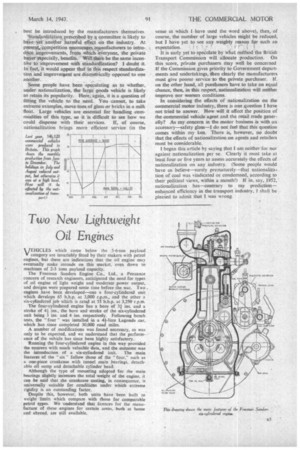Two New Lightweight Oil Engines
Page 37

If you've noticed an error in this article please click here to report it so we can fix it.
VJEHICLES which come below the 5-6-ton payload V category are invariably fitted by their makers with petrol engines, but there are indications that the oil engine may eventually make inroads on this market, even down to machines of 2-3 tons payload capacity.
The Freeman Sanders Engine Co., Ltd., a Penzance concern of research engineers, anticipated the need for types of oil engine of light weight and moderate power output, and designs were prepared some time before the war. Two. engines have been developed—one a four-cylinderecl unit which develops 65 b.h:p. at 3,000 r.p.m., and the other a six-cylindered job which is rated at 55 b.h.p. at 3,250 r.p.rn.
The four-cylindered engine has a bore of 31 ins, and a stroke of 41 ins., the bore and stroke of the six-cylindered unit being 3 ins. and 4 ins. respectively. Following bench tests, the " four " was installed in a 44-litre Lagonda ear, which has since completed 30,000 road miles.
A number of modifications was found necessary, as vvas only to be expected, and we understand that the performance of the vehicle has since been highly satisfactory.
Running the four-cylindered engine in this way provided the concern with much valuable data, and the outcome was the introduction of a six-cylindered unit. The main features of the "six" follow those of the "four," such as a one-piece crankcase with tunnel main bearings, detachable oil sump and detachable cylinder head.
Although the type of mounting adopted for the main bearings slightly increases the total weight of the engine, it can be said that the crankcase casting, in consequence, is universally suitable for conditions under which extreme rigidity is an outstanding factor.
Despite this, however, both units have been built to weight limits which compare with those for comparable petrol types. We .understand that licences for the 'nano-. facture of these engines for certain areas, both at home and abroad, are still available.




















































































